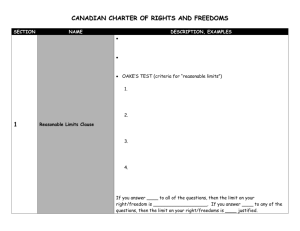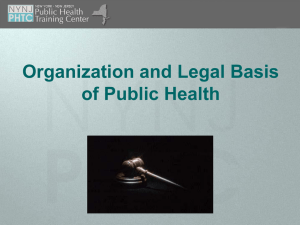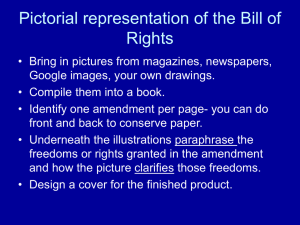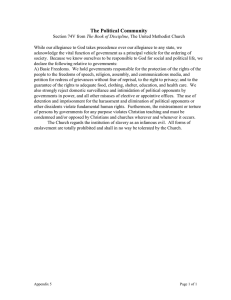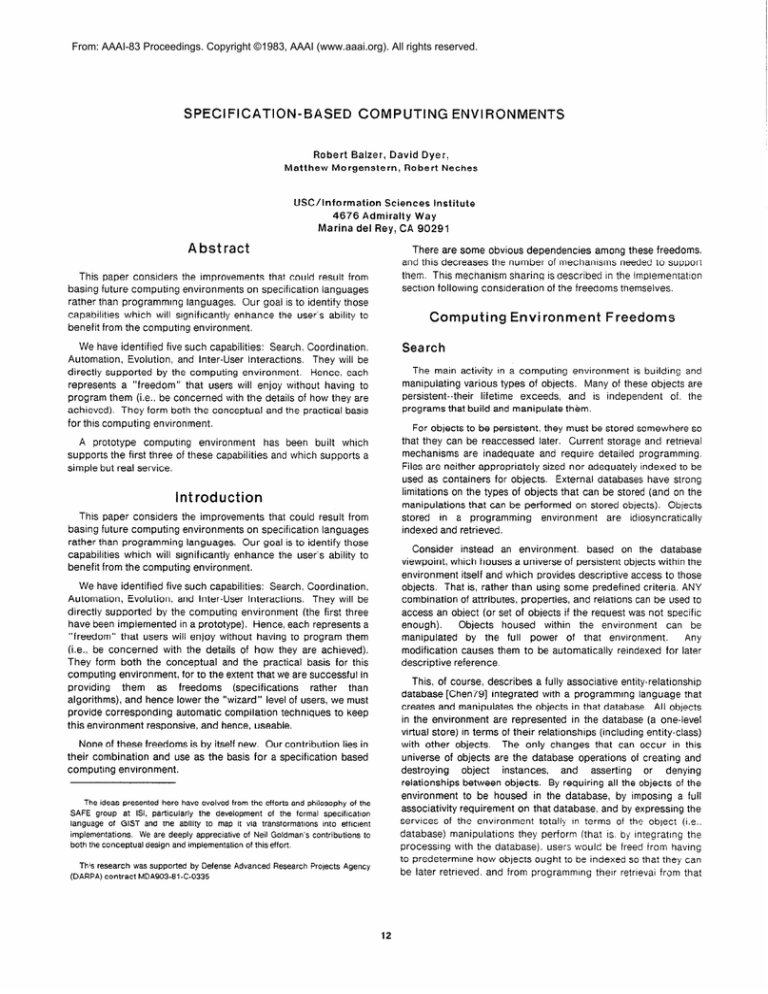
From: AAAI-83 Proceedings. Copyright ©1983, AAAI (www.aaai.org). All rights reserved.
SPECIFICATION-BASED
COMPUTING
ENVIRONMENTS
Robert Baker, David Dye r7
Matthew Morgenstern,
Robert Neches
USC/Information
Sciences Institute
4676 Admiralty Way
Marina del Rey, CA 90291
Abstract
There are some obvious dependencies among these freedoms.
and this decreases the number of mechanisms needed to support
them. This mechanism sharing is aescribed In the lmplementatlon
section following consideratron of the freedoms themselves.
This paper considers the improvements that could result from
basing future computing environments on specification languages
rather than programmtng languages. Our goal is to identify those
capabilities which will srgnificantly enhance the user’s ability to
benefit from the computing environment.
Computing
We have identified five such capabilities: Search. Coordination.
Automation, Evolution. and Inter-User Interactions.
They will be
directly supported by the computing environment.
Hence. each
represents a “freedom” that users will enjoy without having to
program them (i.e., be concerned with the details of how they are
achieved). They form both the conceptual and the practical basis
for this computing environment.
The main activity m a computing environment is building and
mampulating various types of objects. Many of these objects are
persistent--their
lifetime exceeds, and is independent
of. the
programs that build and manipulate th&m.
For objects to be persistent, they must be stored somewhere so
that they can be reaccessed later. Current storage and retrieval
mechanisms are inadequate and require detailed programmmg.
Files are neither appropriately sized nor adequately Indexed to be
used as containers for objects. External databases have strong
limitations on the types of objects that can be stored (and on the
manipulations that can be performed on stored objects). Objects
stored in a programming
environment
are idrosyncraticatly
indexed and retrieved.
introduction
This paper considers the improvements that could result from
basing future computing environments on specification languages
rather than programming languages. Our goal is to identify those
capabilities which will significantly enhance the user’s ability to
benefit from the computing environment.
Consider instead an environment.
based on the database
viewpoint, which houses a universe of persistent objects within the
environment itself and which provides descriptive access to those
objects. That is, rather than using some predefined criteria. ANY
combination of attributes, properties, and relations can be used to
access an object (or set of objects if the request was not specific
Objects housed within the environment
can be
enough).
manipulated
by the full power of that environment.
Any
modification causes them to be automatically reindexed for later
descriptive reference.
We have identified five such capabilities: Search. Coordination,
Automation, Evolution. and Inter-User Interactions.
They will be
directly supported by the computing environment (the first three
have been implemented in a prototype). Hence. each represents a
“freedom” that users will enjoy without having to program them
(i.e., be concerned with the details of how they are achieved).
They form both the conceptual and the practical basis for this
computing environment, for to the extent that we are successful in
providing
them
as freedoms
(specifications
rather
than
algorithms), and hence tower the “wizard” level of users, we must
provide corresponding automatic compilation techniques to keep
this environment responsive, and hence, useable.
The ideas
SAFE
presented
group
language
of
at
GIST
implementations.
here
and
the
design
This research
was supported
contract
the
ability
We are deeply
both the conceptual
(DARPA)
have evolved
ISI, particularly
to
map
appreciative
and implementation
MDA903-81
from
the efforts
development
by Defense
it via
of
the
formal
transformations
of Neil Goldman’s
This, of course, describes a fully associative entity-relationship
database [Chen79] integrated with a programming language that
creates and maniputates the objects in that database. All objects
in the environment are represented in the database (a one-level
virtual store) in terms of their relationships (including entity-class)
with other objects.
The only changes that can occur in this
universe of objects are the database operations of creating and
destroying
object
instances,
and
asserting
or
denying
relationships between objects. By requiring all the objects of the
environment to be housed in the database, by imposing a full
associativity requirement on that database, and by expressing the
services of the environment totally in terms of the object (i.e..
database) manipulations they perform (that is. by lntegratmg the
processing with the database), users would be freed from having
to predetermine how objects ought to be indexed so that they can
be later retrieved. and from programmmg their retrlevai from that
lies in
based
and philosophy
of the
specification
into
efficient
contributions
to
of this effort
Advanced
Research
Projects
Freedoms
Search
A prototype computing environment
has been built which
supports the first three of these capabilities and which supports a
simple but real service.
None of these freedoms is by itself new. Our contribution
their combination and use as the basis for a specification
computing environment.
Environment
Agency
C-0335
12
predetermined structure. Much of the complexity and difficulty of
usmg current environments arises from the care and feeding of
such “access structures”.
in this new environment.
any
classification structure merely becomes additronal properties of
the object which can be used, like any others. as part of a
descrrptive reference to that object.
The user interface to this environment would therefore be a set
of perspectives (mappings) used for display. Through them the
user could observe objects. watch them change. invoke tools and
services to manipulate them. or change them himself This user
interface would be fully programmable
and extensible
(see
Evolution below).
Coordination
As an example of the power of the coordination mechanism,
justified text is just a view of text, and object code is just a view of
source code. By defining justification and compilation as the
perspectives which produce those views, these processes will be
automatically
invoked
as needed.
The maintenance
task
(coordinating the objects) will shift from the user to the system.
(Consistency)
Given the ability to create and manipulate persrstent objects
and to access them descriptively.
the next most important
capability is to coordinate sets of such objects _- that is. keep them
consistent with one another.
Whenever one object in such a
coordinated
set changes. the others must be appropriately
updated.
Currently. we attempt to realize such coordination
through procedural embedding.
That is. into each service that
modifies such an object we insert code to update the others.
Since the consistency criteria are not explicit. this currently is
necessarily a manual task and is error prone, both in the
placement and form of the required update.
Such manual
procedural embeddings are a key reason current systems are
complex.
This problem is exacerbated
by the fact that the
servrces: and the relationships among objects affected by these
services. are evolving independently.
Automation
In mteractmg with a computtng envrronment
many repetitive
sequences
are employed
Programming
language
based
environments
provide the ability to bundle such repetitrve
sequences as macros and/or procedures.
But such macros
and/or procedures still have to be invoked explicitly
The user is
required to remain in the loop having to perform the pattern
recognition function and determine when and upon which objects
to Invoke the macro and/or procedures.
Consider instead making the coordination rules explicit so that
coordinated objects are defined in terms of each other. Each
definition
is expressed
in terms of a mapping (called a
perspecfive)
which generates a dependent object (called a view)
from one or more objects with which it is coordinated.
Whenever
a coordinated
object changes,
the view can be updated
automatically
(a
la
Thinglab [Borning77]
and
VisiCalc
[Wolverton81].
Views are first-class objects [Kay74. lngalls781:
they can be accessed descriptively, and, if the back mapping is
defined. they can be modified, causing the appropriate changes in
the “defining” objects.
(Some of these back-mappings can be
inferred automatically [Novak83]; others are underdetermined and
must be explicitly defined.)
By adding demons to the computing environment. users could
be freed from being in-the-loop through automating the way that
their environment reacts to specified situations
Those situations
would become the firing pattern of the demons. and the responses
become their bodies
This would allow users to define active
“agents” operating on their behalf which autonomously monitor
the computing environment
for those situations for which a
response has been defined. This freedom allows users to focus
their attention on the more idiosyncratic aspects of the computing
while their agents handle the more regularized ones. In particular.
these agents could operate in the absence of the user. responding
to interactions initiated from other user’s environments (see InterUser Interactions below).
Such coordination represents a major departure from existing
systems. Coordtnated objects are tightly coupled. so that changes
in one are automatrcally reflected In the others. With such a
mechanism. once the coordmation crrteria (mapprngs) are stated.
the system could assume full responsibility
for maintaining
consrstentcy among coordinated objects.
Changes to existing
services or addition of new ones could be accommodated
automatically.
Furthermore. the system could then employ lazy
evaluation [Friedman761 to delay updating
views until those
updates were actually required.
This automation mechanism not only frees users from repetitive
tasks, but also changes their perception of their environment,
First. it emphasizes the data base orientation of the environment
by basing responses on situations (the state of some set of
objects) rather than on the processes (code) that produced those
As we will see in the next section. this data base
srtuations.
orientation greatly facilitates evolution of the tools and services in
the environment. Second. these responses convert the previously
passive environment into an active one.
As an example of automation,
consider an agent which
responds to the arrival of a message by presorting it for the user
into some predefined catagory on the basis of the sender. the
topic, and/or the content of the message. and then decides
whether to inform the user of its arrival based on the user’s
current activity.
The reason that the terms, perspective
and view. were chosen,
respectively. for the mapping and the object produced is that. in
addition to its intended use as the mechanism to keep objects
coordinated. perspectives will also be used as the mechanism by
which a user displays and manipulates objects, Displays are just
particular views (which like other views must be kept coordinated
with the object being viewed) for which the system knows how to
create a picture on the user display screen and how user gestures
(whether by entering text. making selections, and/or graphical
motion) change the display (and hence, both the picture on the
screen and. via a back mapping, the object being viewed).
Evolution
(Perspecuity)
One
of the
key problems
with traditional
computing
environments is the mabilrty to modify the tools and services of
those environments.
Programming language based environments
improve this situation by coding the tools and services in the
language of the environment (with which the user IS necessarily
familiar) and by making the source code available to the user. To
the extent that the user can understand the tools and services. he
can modify them.
Coordination is thus an extremely powerful mechanism. It not
only provides an explicit mechanism for maintaining consistency
between objects. but also provides the mechanism by which
manipulatable filtered (Le., partial) views could be constructed for
both internal and external (display) use.
Once the commitment has been made to provide accessible
source
code,
evolvability
is ‘almost
completely
an
13
understandability
issue. This is another way that adopting a
specification-based
approach
has a big payoff.
Besides
alleviating implementation
concerns. each of the specification
freedoms improves understandability by allowing the code to more
closely describe intent rather than implementation.
within a single environment.
Objects need to be accessed.
coordinated.
and manipulated across environment boundaries.
The boundary between environments has to be suppressed so
that the full power of the computing environment can be applied to
inter-user interactions.
As a prime example. consider the use of the “automation”
demons. described in the previous section. to provide situationbased extensions.
Rather than procedurally embedding the
extension at each appropriate
place in the existing tools or
services, a single demon is created that specifies when. in terms of
the objects in the environment (i.e.. a situation). the extension is
By localizing the extension and specifying the
appropriate.
situation to which it is to be applied. the understandability of the
resulting service is greatly enhanced. We believe that such rulebased technology
has much wider applicability
than expert
systems.
One remaining issue must be addressed. Within someone else’s
environment,
our rights and privileges are very different from
those within our own. Within our own environment, we can do as
we please--accessing any object, manipulating it, and defining the
rules of consistency which it must obey. Within someone else’s
We must ask
environment. we have no rights and privileges
permission for anything within someone else s environment
We do this by dividing
the notion of ar, active ObJeCt
]Kay74. Hewitt771 into an active mtermeoiary (programmed agent)
If we are
and a (passive) ObJeCt
owned by that intermediary.
that we own. then
manipulating (including accessing) an Object
the manipulation is performed directly.
However. an attempt to
manipulate someone else’s ObJeCt IS treated as (i.e.. translated to)
a request to the owner of that object. which can be either honored
or refused. This specification freedom enables ObJeCt owners to
define external access and manipulation rights that allow others to
manipulate objects without respect to environment boundaries as
long as they don’t exceed those rights. Privacy and/or access
can be programmed on a local object-by-object
basis and can be
both state and requestor dependent.
But tool and service understandability
need not be based solely
on the readability of the source code. These tools and services
manipulate objects in the environment.
That is, they have
behavior,
and that behavior
provides
a strong basis for
understandability [Balzer69].
By making the behavior explicit in
the form of a recorded history (as an object in the environment)
the full power and extensibility
of the viewing (coordination)
mechanism could be used to understand the recorded behavior.
The recorded history would include attribution so that the old
debugging problem of determining how an object reached its
current state and who was responsible for it will finally be
resolved.
Beyond Freedoms:
General Support
Recording
history is a major design commitment of our
computing environment which provides the basis for its behavior
based understandability.
To the extent tnat we are successful in
providing an evolvabie. integrated. and automated computing
environment. the need for such behavior based understanding will
correspondingly increase.
In addition to the specification freedoms described above. two
other capabilities
must be available
within the computing
environment
to simplify service creation
and improve
the
First is a comprehensive set of
habitability of the environment.
general object manipulations.
Since the main activity in any
computing environment
is building and manipulating ObJeCtS.
such a set of widely applicable object manipulations is essential
These manipulations
include object definition
[Goldstein80].
(since the class of object types is not fixed), instantiation (since
the set of objects of each type is not fixed). exammatron (often
called browsing
in interactive
systems), modification.
and
destruction. To the extent that traditional services have employed
providing
a
of these
capabilities.
idiosyncratic
versions
comprehensive set of widely applicable object manipulations will
reduce
service implementation
effort while improving
the
consistency
and coherency
(and hence habitability)
of the
environment.
As an example of such a reduction. consider an
electronic mail service. The only portions of this service which
must be specially built are the definition of the object message
and the mail service specific operations of sending a completed
message (transferring a copy to each of its addressee attributes)
and answering a message (partially constructing a message with
The recorded history also provides the basis for an important
habitability feature--the ability to undo operations [Teitleman72].
There are three reasons why such a capability IS crucral. First. we
are fallible--fro’m lack of forethought or just plain carelessness.
Second. no matter how consrstent and well integrated the
environment is. we will occasionally be unpleasantly surprised at
the effect of an operation. or the situation in which it was invoked.
Finally, users need a convenient way to experiment, to learn about
unfamiliar
servrces. to debug their own additions to the
environment. and simply just to see the effects of some course of
action. For all these reasons. an undo mechanism which can be
invoked after the operation(s) to be undone IS a crucial habitability
feature (as shown by its popularity and use in the Interlisp
[Teitleman 781 environment).
Such a facility can be easily
constructed from the recorded history.
Inter-user
Interaction
So far we have examined the freedoms of search. coordination.
automation, and evolution. These four freedoms resolve the major
difficulties encountered within a computing environment. But our
future computing environments cannot be self-contained.
They
must interact with the environments
of other users and with
various shared services.
the addressees and the beginning of the body (“In reply to your
message o?...“) filled In). All of the other capabilities normally
associated with a mail service such as comparing messages
examining
them. editing them. filing them retnevmg them
deleting them. etc.. are provided through the general object
manrpulation
capabilities
of the environment
Clearly. such
reductions In the scope of service implementatron greatly facilitate
the creation of new services.
As was the case when we considered persistent objects, files
are an inappropriate
mechanism (though they are the basis for
existing inter-user interactions).
Inter-user interactions require no
less powerful nor rich a set of capabilities than those needed
14
introduced.
especially
recalculations
and to
required.
The second additional capability required within the computing
environment is a suitable user interface. As previously discussed
under the coordination freedom. the user interface will be a set of
perspectives (mappings) used to display and manipulate objects.
as an object it can be
By defining a “service invocation”
instantiated. displayed. and manrpulated by this Interface. and by
definrng a service on such objects which Invokes the named
service on the specified objects (parameters). then this interface
interpreter”
to specify the
can be used as a “command
parameters needed for some service and to Invoke it. In addition.
since a wide variety of views will already be needed for user
browsing. these same views can be used to display the effects of
services. In fact, smce all the effects of a servrce invocation are
recorded in the history. a much more sophrstrcated displa)
mechanrsm can eventually be created. external to the services.
which examines the effects and determines what to drsplay based
not only on these effects, but also the current user context
including what is currently displayed on the screen and on various
user declarations of personal preference. By removing both input
(service invocation) and output (how to display effects) from
service definitions.
their scope will be reduced to a kernel
consisting of only the functional object manipulation effects of the
service.
This will greatly
simplify service creation while
simultaneously
providing a more powerful comprehensive user
interface.
coordination
incrementally
to eliminate
unneeded
update those that are
Conclusion
We have examined current computing environments and tried
to understand the causes for their limitations, particularly in the
areas of integration and habitability.
Operating system based
computing environments must be integrated at the subsystem
The narrow communication
channel imposed via files
level.
(whether real or in-core) appears to fundamentally preclude tight
integration.
The situation is very different for programmmg language based
computing environments
They appear structurally ideal for tight
integration
Arbitrary oojects can be defined and shared The full
range of control structures In the programming language can be
used to tie tools and services together
While this programmrnglanguage basis is adequate for rntegratron It causes habitability
problems. The mechanisms are simply too low level (detailed) for
the computrng environment task. Rather than describing what to
do. users must program how to do it. precisely because they are
language
dealing with a programming
The obvious solution is to augment the computing environment
language with higher level specificat/on
constructs.
Each such
construct represents a freedom
that users can enjoy (because
they no longer have to program the construct) and a responsibility
the system must accept to provide an efficient implementation of
the construct to keep the environment responsive
Implementation
A working prototype of this computing environment exists. A
This service
small but real service has been constructed.
maintains a portion of the ISI employee data base including such
information as office, phones, secretary, directory name and
electronic mail location. It uses coordination rules to ensure that
a person’s backup phone is the primary phone of his secretary
and that the person’s primary phone is the phone in his office. It
uses an automation rule to send a message to the receptionist
It also includes a service
whenever someone’s office is changed
specific view which generates an updated phone-list mcorporatrng
all of the above information In a predefined format. We hope to
maintain
thus data base through
our specification
based
computing environment once the prototype becomes sufficiently
robust.
We have identified five such freedoms. They are:
1. Search--the
reference.
ability to locate objects
via descnptrve
2. Coordination--the
ability to state the consistency
criteria among objects and to have it maintained as
any of them are changed.
3. Automation--the
ability to define the autonomous
response to specified situations so that the user need
not remain in the loop for repetitive operations.
Three of the five freedoms
(search. coordination.
and
All three are based on
automation) have been implemented.
existing AP3 [Goldman821 capabilities.
The prototype currently
“compiles”
the service
into the corresponding
AP3 calls.
Coordination and automation both translate into AP3 demons.
The AP3 demons mechanism
itself piggybacks
on AP3’s
So all three
associative
database
retrieval
mechanism.
implemented freedoms rely upon this single powerful facility.
4. Evolution--the
ability to modify and extend existing
services through
increased
perspecuity
of those
services and their behavior.
5. Inter-User Interaction--the
ability to determine how
others will be allowed to access your objects. as they
determine.
None of these freedoms is, by itself, new. Our contribution lies
in their combination and use as the basis for a specification based
computer environment.
In addition,
both aspects
of the “General Support”--a
comprehensive
set of object manipulatron
facilities and a
(primative) interactive user interface--have
been built.
These
object manipulation facilities enable one to interactively view
modify, and extend both instances
of objects and
object
definitions themselves.
We have no doubt that such freedoms. together with a
comprehensive
set of general object manipulations and user
interface capabilities. will greatly facilitate service creation and
markedly
improve
the
habitability
of future
computmg
envrronments.
These freedoms must oe supported wrth efficient
mechanrsms. Two mechanisms seem most crucial. The frrst IS an
This requrred
adaptive associative entity-relationship
database
mtegration
of
techniques
developed
In the
database.
and
artificial
mtelligence
ftelds
programmmg
language
[Goldman821 and has been used to Implement tne first three
freedoms.
The second IS view maintenance.
It requires the
Our current efforts are focused on creation of a suitable
language for expressing actions, coordmatton. and automations
and on recording
history
so that we can address the
comprehension and modifiability requirements of the evolution
freedom.
Once we have completed the conceptual framework, a major
effort will be focused on optimizing the specification freedoms
15
integration of techniques for obsolescence detection. lazy (and
opportunistic)
evaluation.
generation
of back-mappings.
and.
most important. incremental update.
The open question is how long it will take to provide this
underlying support technology.
Our working prototype is merely a
first step. All the hard optimization problems and many of the
conceptual modeling ones are still ahead of us.
[Goldstein 801 I. Goldstein and D. Bobrow, “Descriptions
Programming
Environment”,
Proceeding
of the
[Balzer
691 R. Balzer. “Exdams
- Extensible Debugging and
Monitoring Systems”,
Proceedings
of the Spring
Joint
Computer
Conference,
1969, pp. 567-580.
[Borning 771 A. Borning, “Thinglab -- An Object Oriented System
of
for Building Simulation Using Constraints”, Proceedings
the
Fifth
International
Intelligence,
[Chen
Cambridge,
791 P. P. Chen
Conference
Analysis
Joint
(ed.),
on
Artificial
Mass., Aug. 1977.
Proceedings
on Entity-Relationship
and Design,
Conference
of
the
Approach
International
to Systems
Los Angeles, Dec. 1979.
[Friedman 761 D. P. Friedman and D. S. Wise, “CONS Should Not
Evaluate Its Arguments”, in Michaelson and Milner (eds.).
Automator,
Languages,
and
Programming.
Edinburgh
University Press, 1976, pp. 257-284
[Goldman
821 N. M.
USC/Information
Goldman,
“AP3
Reference
Sciences Institute, June 1982.
Manual”,
Conference
Artificial
Intelligence,
of
the
Amencan
Association
First
for
Stanford, Calif., 1980.
[Hewitt 771 C. E. Hewitt and H. Baker, “Laws for Communicating
Parallel Processes”, Proceedings
of /F/P-77, Toronto, Aug.
1977
[lngalls
References
Annual
for a
781 D. Ingalls. “The SmalltalkProgrammmg System:
Design and Implementation”
In 5th ACM Symposrum on
Pnnciples of Programming Languages. ACM 1978
[Kay 741 A. Kay. “SMALLTALK.
A Communication
Median for
Children of All Ages”. Xerox Palo Alto Research Center.
Palo Alto. Calif. 1974
[Novae 831 G. Novak. Jr.. “Knowledge-based
Programming Using
3rd Nat/ona/
Abstract Data Types”. AAAi Proceedings
Wash.. D.C. 1983.
Conference
on Artif/cia/ Inrelhgence.
[Teitelman 721 Warren Teitelman, “Automated
Programmer’s
Assistant”, Proceedings
Computer
Conference.
Dec. 1972
Programming . The
of the
[Teitelman 781 Warren Teitelman
lnterllsp
Reference
Xerox Palo Alto Research Center. Oct. 1978
[Wolverton 811 Van Wolverton. IBM Personai
Personal Software Inc.. 1981.
Comwter
Fali
Joint
Manual.
VksiCalc,

